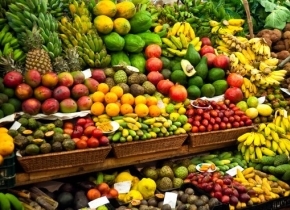Nutrition Guidelines Healthy for the Planet, Too
营养指南对地球也有利
Following dietary guidelines would mean eating less meat and dairy—and fewer calories overall—reducing greenhouse gases and other pollution.
遵循膳食指南意味着少食肉和乳制品,以及总体少摄入卡路里,这么做可以减少温室气体排放,减轻其他污染。
撰文/播音 Julia Rosen 茱莉亚•罗森
翻译 张心茹
校对 郭晓
You know those nutrition guidelines the government issues every few years? It turns out that following them isn’t just good for your health. It’s good for the planet, too.
你知道政府每几年发布一次的那些营养膳食指南吗?事实证明,遵循这些指南不仅对自身健康有利,还有利于我们生存的星球。
“What we found is that impacts vary across nations, but in the high-impact nations, in general, you can see that, if you follow a nationally recommended diet, despite the fact that these diets don’t mention explicitly—or most of them don’t explicitly mention—environmental impacts, that you are going to have lower environmental impacts due to that. So that’s sort of fairly clear across all the high-income nations.”
“我们发现(营养膳食指南的)影响因国家而异,但总的来说,在影响力较大的国家,如果你遵循国家推荐的膳食指南,即使这些膳食并未明晰对环境的影响,或者大多数膳食没有明确说明这一点,但是你对环境的影响会因为遵循指南而减轻。这一现象在所有高收入国家中均有体现。”
Paul Behrens, an environmental scientist at Leiden University in the Netherlands. The food we eat takes a big toll on the environment. A third of the ice-free land on Earth is used for agriculture, and according to some estimates, producing food accounts for roughly a fifth of all human-caused greenhouse gas emissions. Fertilizer runoff also leads to other problems, like the algae blooms in Lake Eerie and the Dead Zone in the Gulf of Mexico.
荷兰莱顿大学(Leiden University)的环境学家保罗•贝恩(Paul Behrens)如是说。我们所吃的食物给环境带来了巨大代价。地球上三分之一的无冰区被用于农业生产,根据一些估算,食物生产大约占到了人类造成的温室气体排放量的五分之一。肥料径流也导致了其他问题,例如伊利湖(Lake Eerie)的藻类爆发以及墨西哥湾(Gulf of Mexico)的死亡区域
However, following dietary guidelines would reduce those impacts, especially in wealthy countries like the US. “Most of the reductions come from meat and dairy,” which have an outsized impact on land use and pollution, and are a major source of greenhouse gases. (That’s partly due to cow farts. Seriously.) Heeding recommendations would also mean eating fewer calories, since many people here eat more than they need.
然而,遵循膳食指南可以减轻这些影响,尤其是在富裕国家,例如美国。“减少大多数东西来自肉和乳制品,”这些食物对土地使用和污染有巨大影响,也是温室气体的主要来源。(这部分因为奶牛放屁,真的。)听取建议也意味着少摄入卡路里,因为很多人吃的超过了他们的需要。
Overall, in high-income countries, Behren’s team estimates that following the rules could result in as much as a 17 percent reduction in land use, a 21 percent reduction in nutrient pollution, and a 25 percent drop in agricultural greenhouse gas emissions. Cutting down on how much food we waste—which is roughly a third in the U.S.—could help even more. The results are in the Proceedings of the National Academy of Sciences. [Paul Behrens et al., Evaluating the environmental impacts of dietary recommendations]
总的来说,贝恩的团队估计,在高收入国家,遵循这些规则可以减少17%的土地使用量,21%的营养污染以及25%的农业中温室气体排放。减少食物浪费的效果更加明显,而这些浪费了的食物是美国食物量的三分之一。这些结果发表于《美国国家科学院学报》里。[Paul Behrens et al., Evaluating the environmental impacts of dietary recommendations]
Of course, people are notoriously bad at following diets. But: “These nationally recommended guidelines do actually have a knock-on effect to other areas of policy making. So if I’m developing a new healthy-eating-for-schools program then that’s going to be based off a lot of detail that I get from the nationally recommended guidelines. So while it might not necessarily be the case that people follow directly…they actually are quite influential on the preparation of other advice.”
当然,人们在遵循膳食指南方面表现糟糕。但是“这些国家推荐的膳食指南确实对其他领域的政策制定有连锁作用。因此,如果我开展一个新的校园健康饮食计划,它会基于我从国家膳食指南中摘取的详细内容。因此,虽然人们不必直接遵循指南,但实际上这些指南在准备其他建议时有很大的影响力。”
Seems that a smaller environmental footprint and a healthier lifestyle could go hand in hand
(通过膳食指南)似乎减轻环境伤害,过上健康生活,二者可以兼得。
—Julia Rosen


 京公网安备11010502039775号
京公网安备11010502039775号